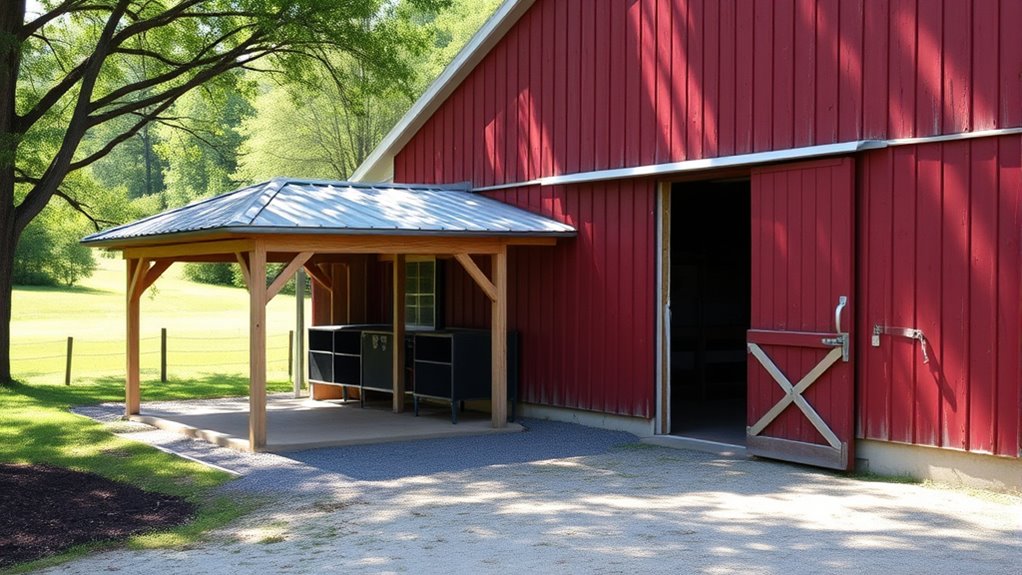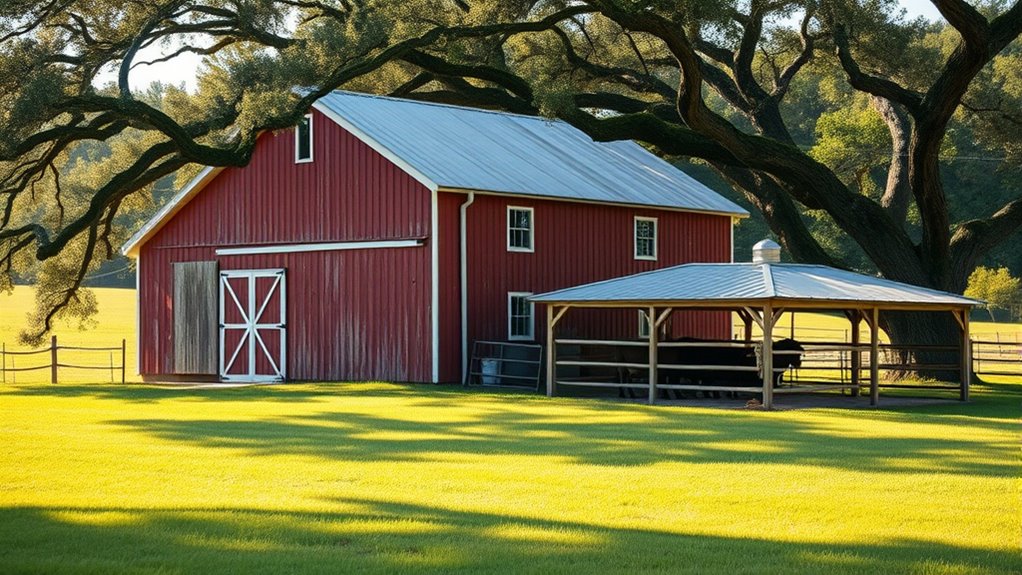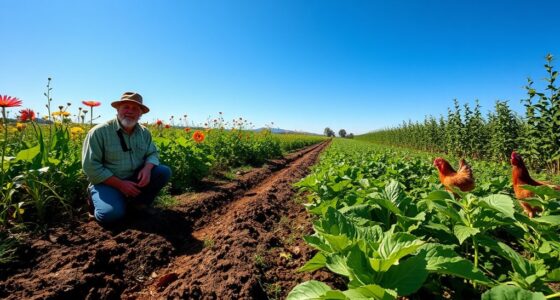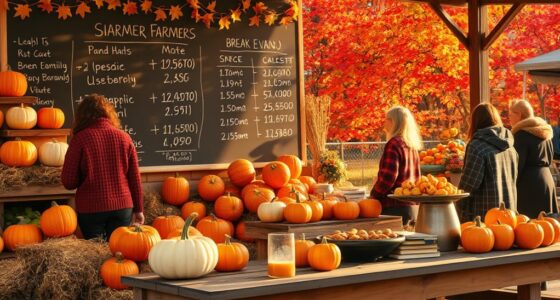When designing your barn and shelters for your homestead, focus on good ventilation to keep air fresh and control humidity. Choose sustainable materials like reclaimed wood or bamboo that last longer and are eco-friendly. Consider insulation and proper material choices to maintain a stable environment for your animals, especially during extreme weather. Guarantee the structure is durable, easy to clean, and functional for storage and daily chores. Keep these basics in mind, and you’ll create spaces that support healthy livestock and long-term success.
Key Takeaways
- Prioritize proper ventilation using natural or mechanical systems to ensure good airflow and reduce humidity and harmful gases.
- Select sustainable, durable materials like reclaimed wood or recycled metal for longevity and environmental benefits.
- Incorporate adequate insulation and thermal management to maintain stable interior temperatures in varying weather conditions.
- Design with weather-resistant, corrosion-proof materials and a solid foundation for structural stability and longevity.
- Plan for easy maintenance and efficient layout, including sufficient storage, natural lighting, and animal comfort features.

Ever wondered what makes a barn or shelter both functional and durable? It starts with understanding the core principles behind good design. One of the most critical factors is livestock ventilation. Proper airflow keeps your animals healthy by reducing humidity, removing excess heat, and dispersing harmful gases like ammonia. Without adequate ventilation, your livestock can become stressed or sick, which affects their productivity and well-being. When designing your shelter, think about natural ventilation options, such as strategically placed windows, vents, or adjustable louvers that promote air circulation without causing drafts. Mechanical ventilation can also be effective, especially in larger or more enclosed structures, but it requires careful planning to guarantee it doesn’t disturb your animals. Additionally, modern technology has introduced advanced ventilation systems that can further optimize airflow and climate control within your barn. Ensuring proper air quality is essential for maintaining a healthy environment for your livestock and reducing disease risks.
Good barn design prioritizes natural and mechanical ventilation for healthier, stress-free livestock.
Another essential aspect is choosing sustainable building materials. Opting for eco-friendly options not only benefits the environment but also enhances the longevity and safety of your barn. Materials like reclaimed wood, bamboo, or recycled metal can be durable, cost-effective, and environmentally responsible. These sustainable choices often provide better insulation and resist pests and decay, reducing maintenance costs over time. Additionally, incorporating natural or low-impact materials helps create a healthier environment for both your animals and yourself, especially if you spend a lot of time in or around the shelter.
When selecting building materials, consider their thermal properties as well. Good insulation can help maintain a stable temperature inside the barn, making it more comfortable for your livestock during extreme weather. You want to avoid materials that trap moisture or promote mold growth, which can jeopardize animal health. Properly sealed and insulated walls, combined with natural ventilation, create a balanced environment that minimizes stress on your animals and keeps your shelter more energy-efficient.
Designing with durability in mind also means paying attention to the foundation and structural elements. Using corrosion-resistant metals or treated wood can withstand weather extremes, while a solid foundation prevents settling or shifting over time. Incorporate simple, practical features like easy-to-clean surfaces and sufficient storage space to streamline maintenance and improve overall functionality. Remember that a well-thought-out layout makes daily chores easier and reduces stress on your livestock, contributing to a healthier, more productive homestead.
Frequently Asked Questions
How Do I Choose the Right Materials for My Barn?
When choosing building materials for your barn, think about durability considerations first. You want materials that withstand weather, pests, and heavy use. Opt for sturdy options like treated wood, metal, or concrete depending on your climate and budget. Consider maintenance needs and longevity, ensuring your shelter remains strong over time. By prioritizing durability, you’ll select materials that keep your barn safe, functional, and cost-effective for years to come.
What Are the Best Ventilation Options for Livestock Shelters?
To guarantee proper ventilation in your livestock shelters, you should focus on natural airflow and effective ventilation systems. Incorporate adjustable vents or windows that promote cross-ventilation, allowing fresh air to circulate and reduce humidity. Installing exhaust fans or ridge vents can help improve airflow during extreme weather. Prioritize strategic placement of openings to maximize natural airflow, keeping your animals comfortable, healthy, and free from respiratory issues.
How Can I Design a Barn for Energy Efficiency?
Think of your barn like a wise old oak, absorbing sunlight and conserving energy. To design for energy efficiency, optimize solar orientation by positioning the barn to maximize passive solar gain. Use insulation techniques like thick walls and reflective barriers to keep warmth in during winter and keep it out during summer. Incorporate natural ventilation to reduce reliance on energy-consuming systems, making your barn both eco-friendly and cost-effective.
What Are Safety Considerations During Barn Construction?
During barn construction, you should prioritize safety by using fire-resistant materials to reduce fire risks. Guarantee the structural integrity of the building by following proper engineering standards and using quality materials. Keep the construction site organized to prevent accidents, and wear appropriate safety gear. Regularly inspect the work to identify potential hazards early. By focusing on these safety considerations, you help create a secure environment for both workers and future barn users.
How Do Local Climate Conditions Influence Barn Design?
Imagine your barn as a sturdy ship steering local climate conditions. Climate adaptation shapes your design—think insulation for cold winters or ventilation for humid summers. Use local materials that naturally suit the environment, making your barn more resilient and eco-friendly. By tailoring your barn to these conditions, you create a safe, comfortable space that withstands weather’s unpredictable whims, ensuring your homestead’s success for years to come.
Conclusion
Now that you’ve got the basics down, your barn and shelter can become the sturdy heart of your homestead, like a reliable anchor in a storm. Think of your design as a well-tuned symphony, where every part works in harmony to keep your animals safe and your land thriving. With a little planning and love, your shelter will stand tall and proud, ready to shelter your dreams and the creatures that make your homestead home.










